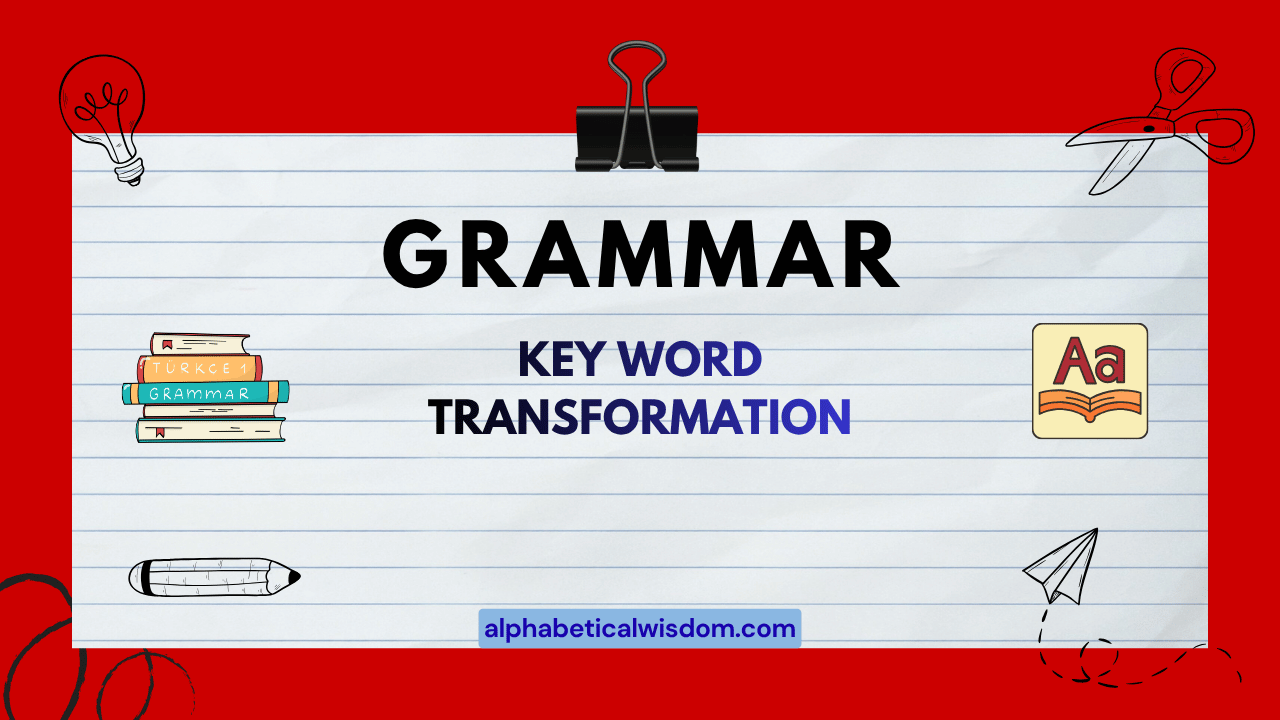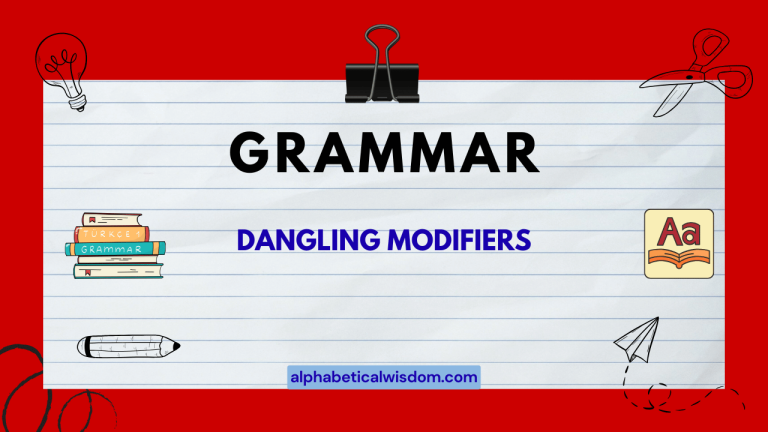Key Word Transformation: Mastering Sentence Restructuring
Key Word Transformation is a crucial skill in English language proficiency tests and everyday communication. It requires you to rephrase a sentence while maintaining its original meaning, using a given “key word.” Mastering this technique enhances your understanding of grammar, vocabulary, and sentence structure.
This article will provide a comprehensive guide to Key Word Transformation, covering its definition, structural breakdown, types, usage rules, common mistakes, practice exercises, advanced topics, and frequently asked questions. This guide benefits English language learners, test takers preparing for exams like Cambridge English Qualifications, and anyone seeking to improve their overall English proficiency.
This skill demands a deep understanding of synonyms, paraphrasing, and grammatical structures. By mastering Key Word Transformation, you’ll improve your ability to express ideas in different ways, a valuable asset in both written and spoken English.
Whether you are aiming for a high score on an English exam or simply want to communicate more effectively, this article will equip you with the knowledge and skills you need to succeed.
Table of Contents
- Definition of Key Word Transformation
- Structural Breakdown
- Types of Key Word Transformation
- Examples of Key Word Transformation
- Usage Rules
- Common Mistakes
- Practice Exercises
- Advanced Topics
- FAQ
- Conclusion
Definition of Key Word Transformation
Key Word Transformation is a task where you are given a sentence and a “key word.” Your goal is to rewrite the original sentence so that it has a similar meaning, using the key word in your new sentence. The key word must not be changed in any way.
This exercise tests your ability to manipulate sentence structure and vocabulary without altering the original meaning. It assesses your understanding of grammar, synonyms, and different ways to express the same idea.
This skill is often found in English language exams, particularly those assessing advanced levels of proficiency. It’s not merely about finding a synonym for a word; it requires a more nuanced understanding of how sentences are constructed and how meaning can be conveyed through different grammatical structures.
You’ll need to consider word order, verb tenses, and the appropriate use of prepositions and conjunctions to successfully complete these transformations. The ability to perform Key Word Transformations effectively demonstrates a strong command of the English language.
Classification
Key Word Transformation falls under the broader category of sentence transformation exercises. These exercises aim to test your ability to express the same idea using different grammatical structures or vocabulary.
Other types of sentence transformation exercises might involve changing the voice of a sentence (active to passive), combining two sentences into one, or changing a statement into a question. Key Word Transformation is unique because it specifically requires the use of a provided word, adding an extra layer of complexity.
Function
The primary function of Key Word Transformation exercises is to assess your command of English grammar and vocabulary. It tests your understanding of synonyms, paraphrasing, and the ability to manipulate sentence structure while preserving meaning.
It also evaluates your ability to identify the core meaning of a sentence and express it in a different way, which is a crucial skill for effective communication. Success in Key Word Transformation demonstrates a high level of linguistic competence.
Contexts
Key Word Transformation is commonly found in various contexts, including:
- English Language Exams: Cambridge English Qualifications (e.g., FCE, CAE, CPE), IELTS, TOEFL.
- Language Learning Activities: Used by teachers to reinforce grammar and vocabulary concepts.
- Writing Skills Development: Helps improve writing fluency and the ability to express ideas in different ways.
- Professional Communication: Useful for writing reports, emails, and other professional documents where clarity and precision are essential.
Structural Breakdown
Understanding the structural elements involved in Key Word Transformation is crucial for mastering this skill. This section breaks down the key components and patterns you need to recognize and manipulate.
Identifying Key Elements
Before attempting a Key Word Transformation, carefully identify the following elements in the original sentence:
- The Core Meaning: What is the main idea the sentence is trying to convey?
- Key Information: What are the essential details that must be retained in the transformed sentence?
- Grammatical Structures: What grammatical structures are being used (e.g., tenses, clauses, passive voice)?
- Vocabulary: Are there any specific words or phrases that are crucial to the meaning?
Understanding these elements helps you focus on what needs to be preserved and what can be altered during the transformation.
Analyzing the Key Word
The key word provided is the anchor of your transformation. Analyze it carefully, considering the following:
- Part of Speech: Is it a noun, verb, adjective, adverb, preposition, or conjunction?
- Meaning: What is its primary meaning and any related meanings or connotations?
- Possible Grammatical Structures: What grammatical structures can it be used in (e.g., verb + infinitive, noun + preposition)?
Knowing the key word’s properties will guide you in constructing a grammatically correct and meaningful sentence.
Transforming the Sentence
The transformation process involves several steps:
- Replace: Substitute words or phrases in the original sentence with synonyms or equivalent expressions that accommodate the key word.
- Rearrange: Change the word order or sentence structure to incorporate the key word naturally.
- Add: Add necessary words (articles, prepositions, auxiliary verbs) to create a grammatically correct sentence.
- Omit: Remove unnecessary words or phrases that are redundant or don’t fit the new structure.
- Combine: Merge elements from different parts of the original sentence to create a cohesive new sentence.
These steps are often performed in combination to achieve the desired transformation.
Types of Key Word Transformation
Key Word Transformations can be categorized based on the type of grammatical or lexical change required. Understanding these categories can help you approach different transformations more effectively.
Passive to Active Voice
Transforming a sentence from passive to active voice involves identifying the agent (the one performing the action) and making it the subject of the sentence. The object of the passive sentence becomes the object of the active sentence.
This often requires changing the verb form.
Active to Passive Voice
Conversely, transforming from active to passive voice involves making the object of the active sentence the subject of the passive sentence. The verb is changed to a passive form (be + past participle), and the agent (the one performing the action) can be included using “by.”
Conditionals
Transformations involving conditionals (if clauses) often require changing the type of conditional (e.g., from first conditional to second conditional) or using alternative expressions like “unless,” “provided that,” or “as long as.”
Reported Speech
These transformations involve changing direct speech (what someone said) into reported speech (what someone said indirectly). This typically requires changing verb tenses, pronouns, and time expressions.
Relative Clauses
Transformations involving relative clauses often require combining two sentences into one using relative pronouns (who, which, that) or relative adverbs (where, when, why), or reducing relative clauses to participial phrases.
Gerunds and Infinitives
These transformations involve changing a verb from a gerund (verb + -ing) to an infinitive (to + verb) or vice versa, often requiring adjustments to the sentence structure.
Comparatives and Superlatives
Transformations involving comparatives and superlatives require changing the degree of comparison (e.g., from comparative to superlative) or using alternative expressions like “as…as” or “the least.”
Modal Verbs
Transformations involving modal verbs (can, could, may, might, must, should, will, would) often require replacing one modal verb with another that expresses a similar meaning, or using alternative expressions like “be able to,” “be allowed to,” or “have to.”
Examples of Key Word Transformation
This section provides extensive examples of Key Word Transformation, organized by category. Each example includes the original sentence, the key word, and the transformed sentence.
Passive to Active Voice Examples
The following table shows examples of transforming sentences from passive to active voice.
| Original Sentence | Key Word | Transformed Sentence |
|---|---|---|
| The cake was eaten by John. | ATE | John ate the cake. |
| The letter was written by Mary. | WROTE | Mary wrote the letter. |
| The car was driven by him. | DROVE | He drove the car. |
| The house was built by them. | BUILT | They built the house. |
| The book was read by her. | READ | She read the book. |
| The window was broken by the children. | BROKE | The children broke the window. |
| The song was sung by the choir. | SANG | The choir sang the song. |
| The picture was painted by the artist. | PAINTED | The artist painted the picture. |
| The food was cooked by my mother. | COOKED | My mother cooked the food. |
| The story was told by my grandfather. | TOLD | My grandfather told the story. |
| The door was opened by the wind. | OPENED | The wind opened the door. |
| The email was sent by Jane. | SENT | Jane sent the email. |
| The report was written by the team. | WROTE | The team wrote the report. |
| The decision was made by the committee. | MADE | The committee made the decision. |
| The mistake was noticed by the manager. | NOTICED | The manager noticed the mistake. |
| The prize was won by Sarah. | WON | Sarah won the prize. |
| The game was played by the children. | PLAYED | The children played the game. |
| The movie was watched by everyone. | WATCHED | Everyone watched the movie. |
| The question was answered by him. | ANSWERED | He answered the question. |
| The problem was solved by her. | SOLVED | She solved the problem. |
Active to Passive Voice Examples
The following table shows examples of transforming sentences from active to passive voice.
| Original Sentence | Key Word | Transformed Sentence |
|---|---|---|
| John ate the cake. | WAS | The cake was eaten by John. |
| Mary wrote the letter. | WRITTEN | The letter was written by Mary. |
| He drove the car. | DRIVEN | The car was driven by him. |
| They built the house. | BUILT | The house was built by them. |
| She read the book. | READ | The book was read by her. |
| The children broke the window. | BROKEN | The window was broken by the children. |
| The choir sang the song. | SUNG | The song was sung by the choir. |
| The artist painted the picture. | PAINTED | The picture was painted by the artist. |
| My mother cooked the food. | COOKED | The food was cooked by my mother. |
| My grandfather told the story. | TOLD | The story was told by my grandfather. |
| The wind opened the door. | OPENED | The door was opened by the wind. |
| Jane sent the email. | SENT | The email was sent by Jane. |
| The team wrote the report. | WRITTEN | The report was written by the team. |
| The committee made the decision. | MADE | The decision was made by the committee. |
| The manager noticed the mistake. | NOTICED | The mistake was noticed by the manager. |
| Sarah won the prize. | WON | The prize was won by Sarah. |
| The children played the game. | PLAYED | The game was played by the children. |
| Everyone watched the movie. | WATCHED | The movie was watched by everyone. |
| He answered the question. | ANSWERED | The question was answered by him. |
| She solved the problem. | SOLVED | The problem was solved by her. |
Conditionals Examples
The following table shows examples of transformations involving conditionals.
| Original Sentence | Key Word | Transformed Sentence |
|---|---|---|
| If it rains, I will stay home. | UNLESS | Unless it doesn’t rain, I will stay home. |
| If you study hard, you will pass the exam. | PROVIDED | Provided that you study hard, you will pass the exam. |
| If I were rich, I would travel the world. | WERE | Were I rich, I would travel the world. |
| If he had studied, he would have passed. | HAD | Had he studied, he would have passed. |
| You can borrow my car if you are careful. | LONG | As long as you are careful, you can borrow my car. |
| If you don’t hurry, you’ll miss the bus. | WILL | You will miss the bus unless you hurry. |
| If she practices, she will improve. | PRACTICE | She will improve provided she practices. |
| If they arrive late, we will start without them. | SHOULD | Should they arrive late, we will start without them. |
| If I knew the answer, I would tell you. | KNEW | Were I to know the answer, I would tell you. |
| If he apologizes, I will forgive him. | APOLOGIZE | Unless he doesn’t apologize, I will forgive him. |
| If you mix red and blue, you get purple. | MIXING | Mixing red and blue results in purple. |
| If it hadn’t rained, we would have gone out. | RAINED | Had it not rained, we would have gone out. |
| If she had known, she would have helped. | KNOWN | Had she known, she would have helped. |
| If he doesn’t call, I’ll assume he’s busy. | CALLS | Unless he calls, I’ll assume he’s busy. |
| If you need help, just ask. | SHOULD | Should you need help, just ask. |
| If I could fly, I would visit the moon. | ABLE | Were I able to fly, I would visit the moon. |
| If she had listened, she would have understood. | LISTENED | Had she listened, she would have understood. |
| If they don’t agree, we’ll have to compromise. | AGREE | Unless they agree, we’ll have to compromise. |
| If you pay attention, you’ll learn something. | ATTENTION | As long as you pay attention, you’ll learn something. |
| If I had known the truth, I would have acted differently. | KNOWN | Had I known the truth, I would have acted differently. |
Reported Speech Examples
The following table shows examples of transformations involving reported speech.
| Original Sentence | Key Word | Transformed Sentence |
|---|---|---|
| He said, “I am tired.” | THAT | He said that he was tired. |
| She said, “I will go to the party.” | WOULD | She said she would go to the party. |
| They said, “We are going to the beach.” | WERE | They said they were going to the beach. |
| He asked, “Are you coming?” | IF | He asked if I was coming. |
| She asked, “What time is it?” | WHAT | She asked what time it was. |
| He said, “I have finished my work.” | HAD | He said that he had finished his work. |
| She said, “I can help you.” | COULD | She said she could help me. |
| They said, “We will be there by 5.” | WOULD | They said they would be there by 5. |
| He asked, “Did you see the movie?” | WHETHER | He asked whether I had seen the movie. |
| She asked, “Where are you going?” | WHERE | She asked where I was going. |
| He said, “I saw her yesterday.” | SEEN | He said he had seen her the day before. |
| She said, “I am leaving tomorrow.” | LEAVING | She said she was leaving the following day. |
| They said, “We have been waiting for hours.” | WAITING | They said they had been waiting for hours. |
| He asked, “Can you help me with this?” | COULD | He asked if I could help him with that. |
| She asked, “Will you be there?” | WOULD | She asked if I would be there. |
| He said, “I might be late.” | MIGHT | He said he might be late. |
| She said, “I must go now.” | HAD | She said she had to go then. |
| They said, “We should call him.” | SHOULD | They said they should call him. |
| He asked, “Have you finished?” | FINISHED | He asked if I had finished. |
| She asked, “Why are you here?” | WHY | She asked why I was there. |
Usage Rules
Key Word Transformation requires strict adherence to certain rules to ensure that the transformed sentence is grammatically correct and retains the original meaning.
Do Not Change the Key Word
The most important rule is that you must not change the key word in any way. This includes changing its form (e.g., from noun to verb), adding prefixes or suffixes, or using a synonym. The key word must be used exactly as it is given.
Maintain the Original Meaning
The transformed sentence must have the same meaning as the original sentence. This means you need to understand the core message of the original sentence and ensure that the transformed sentence conveys the same message accurately.
Grammatical Correctness
The transformed sentence must be grammatically correct. This includes using the correct verb tenses, subject-verb agreement, word order, and punctuation.
Pay attention to the grammatical context of the key word and ensure that it is used correctly within the new sentence structure.
Word Limit
In many Key Word Transformation exercises, there is a word limit for the transformed sentence. You must stay within this limit.
This requires you to be concise and efficient in your use of words.
Use of Contractions
Whether or not contractions are allowed depends on the specific instructions of the exercise. If contractions are allowed, use them sparingly and appropriately.
Avoid using contractions in formal writing unless explicitly permitted.
Common Mistakes
Learners often make certain common mistakes when attempting Key Word Transformation exercises. Understanding these mistakes can help you avoid them.
Changing the Key Word
Incorrect: Original: I like swimming. Key Word: ENJOY. Transformation: I enjoyable swimming.
Correct: Original: I like swimming. Key Word: ENJOY. Transformation: I enjoy swimming.
The first example incorrectly alters the word “enjoy” to “enjoyable,” thus invalidating the transformation.
Altering the Meaning
Incorrect: Original: He is taller than me. Key Word: AS. Transformation: I am as tall as him.
Correct: Original: He is taller than me. Key Word: AS. Transformation: I am not as tall as him.
The first example reverses the meaning; the correct transformation maintains that he is taller.
Grammatical Errors
Incorrect: Original: She went to the store. Key Word: DID. Transformation: Did she went to the store?
Correct: Original: She went to the store. Key Word: DID. Transformation: Did she go to the store?
The first example uses the incorrect verb form “went” after “did,” violating basic grammar rules.
Exceeding Word Limit
Incorrect: Original: I am very happy. Key Word: EXTREMELY. (Word limit: 3). Transformation: I am extremely very happy.
Correct: Original: I am very happy. Key Word: EXTREMELY. (Word limit: 3). Transformation: I am extremely happy.
The first example uses more words than allowed, failing to adhere to the exercise’s conditions.
Incorrect Word Order
Incorrect: Original: He is a good student. Key Word: SUCH. Transformation: He is a student such good.
Correct: Original: He is a good student. Key Word: SUCH. Transformation: He is such a good student.
The first example presents an incorrect word order, disrupting the sentence’s grammatical structure.
Practice Exercises
Test your understanding of Key Word Transformation with these practice exercises. Each exercise includes the original sentence, the key word, and space for you to write your transformed sentence.
Answers are provided at the end of the section.
Exercise 1
| Question | Key Word | Your Answer |
|---|---|---|
| I started learning English five years ago. | FOR | |
| She is a better singer than her sister. | AS | |
| They didn’t allow me to enter the building. | ALLOWED | |
| It’s possible that he is at home. | MAY | |
| I haven’t seen him since last year. | SAW | |
| She is too young to drive a car. | ENOUGH | |
| He is not as intelligent as his brother. | THAN | |
| They made me clean the house. | MADE | |
| It’s against the rules to use your phone here. | SUPPOSED | |
| I prefer tea to coffee. | RATHER |
Exercise 2
| Question | Key Word | Your Answer |
|---|---|---|
| He regrets not studying harder. | WISHES | |
| She is said to be a good doctor. | SAID | |
| They are going to sell their house. | SOLD | |
| I can’t afford to buy a new car. | EXPENSIVE | |
| She is very good at playing the piano. | EXCELLENT | |
| It was wrong of you to say that. | SHOULDN’T | |
| He is looking forward to his vacation. | FORWARD | |
| She is not interested in sports. | INTEREST | |
| They are responsible for the damage. | RESPONSIBILITY | |
| I don’t like him. | DISLIKE |
Exercise 3
| Question | Key Word | Your Answer |
|---|---|---|
| He is likely to win the race. | PROBABLE | |
| She is always late. | NEVER | |
| They are planning to go to Italy. | PLAN | |
| I am sure he is innocent. | MUST | |
| She is better than me at tennis. | GOOD | |
| It is necessary to wear a helmet. | HAVE | |
| He is not allowed to smoke here. | SUPPOSED | |
| She is similar to her mother. | LIKE | |
| They are going to get married. | GETTING | |
| I don’t mind helping you. | HAPPY |
Answer Key
Exercise 1:
- I have been learning English for five years.
- Her sister is not as good a singer as her.
- I wasn’t allowed to enter the building.
- He may be at home.
- I last saw him last year.
- She is not old enough to drive a car.
- His brother is more intelligent than him.
- I was made to clean the house.
- You are not supposed to use your phone here.
- I would rather have tea than coffee.
Exercise 2:
- He wishes he had studied harder.
- It is said that she is a good doctor.
- Their house is going to be sold.
- A new car is too expensive for me to buy.
- She is excellent at playing the piano.
- You shouldn’t have said that.
- He is looking forward to going on vacation.
- She has no interest in sports.
- They have the responsibility for the damage.
- I have a dislike for him.
Exercise 3:
- It is probable that he will win the race.
- She is never on time.
- They plan to go to Italy.
- He must be innocent.
- I am not as good as her at tennis.
- You have to wear a helmet.
- You are not supposed to smoke here.
- She is like her mother.
- They are getting married.
- I am happy to help you.
Advanced Topics
For advanced learners, Key Word Transformation can involve more complex grammatical structures and vocabulary. Here are some advanced topics to explore.
Inversion
Inversion involves changing the normal word order of a sentence (subject-verb) to emphasize a particular element or create a more formal tone. Key words like “never,” “rarely,” “scarcely,” “hardly,” “no sooner,” and “only” often trigger inversion.
Cleft Sentences
Cleft sentences are used to emphasize a particular part of a sentence. They typically start with “It is/was” followed by the emphasized element and a relative clause.
Key words like “what,” “who,” and “that” are often used in cleft sentences.
Elliptical Clauses
Elliptical clauses are clauses where some words are omitted because they are understood from the context. Key words like “so,” “neither,” “nor,” and “than” are often used in elliptical clauses.






